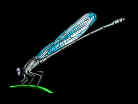The R.C. Dening Collection |
 |
Introduction to Zambian Butterflies
by R.C. Dening F.R.E.S.
Species and Habitats
 |
DISTRIBUTION WITHIN THE SAVANNA BIOME |
| Many
butterfly species rely on foodplants at ground level or in the understorey. Hence
vegetation categories which are based on tree species may have little bearing on the
butterflies' distribution. Moreover, the existence of dominant tree species in a category
does not signify absence of numerous other tree families interspersed in the main stands.
It is possible to walk several hundred yards through Brachystegia forest and find
30-40 woody species.White's Forest Flora of
Northern Rhodesia gives a comprehensive list of the species and their distribution (White,
1962).
Butterfly Species Occurring in most Savanna Habitats A species will occur in a wide range of habitats either
because it has acquired the ability to survive on a variety of foodplant families and
genera, or because its preferred foodplant family is very widely distributed. a) Species with a wide range of larval hosts Charaxes jasius, which has six subspecies ranging from the Mediterranean to South Africa, feeds not only on numerous leguminous trees such as Brachystegia, Bauhinia, Burkea and Afzelia, but also on the families Celastraceae (Maytenus), Malvaceae (Hibiscus), Euphorbiaceae (Croton), Ericaceae (Arbutus), and even the cereal Sorghum. Likewise, Graphium angolanus, which is widespread throughout All Africa Open Formations, feeds not only on several genera of the Annonaceae, but also on Apocynaceae (Landolphia) and Malpighiaceae (Sphedamnocarpus). Again, the cosmopolitan Cynthia cardui feeds on numerous herbaceous plants in the families Compositae, Urticacae, Malvaceae, Leguminosae and Boraginaceae. Other species of Nymphalidae which occur throughout the savanna biome, and whose larvae feed on a range of foodplant families, include Hypolimnas misippus (Acanthaceae and Portulacaceae), Catacroptera cloanthe (Acanthaceae and Asclepiadaceae), and Neptis saclava (Combretaceae and Euphorbiaceae). In addition, many widespread Junonia species such as J.antilope, J.archesia, J.cuama, J.hierta, J.natalica, J.octavia, J.oenone and J.orithya feed on common herbaceous plants in the families Acanthaceae and Labiatae. b) Species where the preferred hostplant family is very widespread However, in many cases, widespread distribution over most savanna habitats is due to the ubiquitous nature of the foodplant family itself. For the genus Papilio, this is Rutaceae (which includes cultivated citrus), making possible the Panafrican distribution of P.demodocus, (which also utilises other food plant families). For Graphium, it is Annonaceae, (which includes cultivated Custard Apple), assuring the widespread distribution of G.leonidas and other related species such as the swordtails.Similarly with the Pieridae, almost all species of the subfamily Pierinae, (except Mylothris), feed preferentially on the ubiquitous family Capparaceae, (or in temperate regions the closely related Brassicaceae). Hence the Old World tropical distribution of Belenois aurota, B.creona and various Colotis species. Species of the subfamily Coliadinae feed mainly on common leguminous plants, which occur throughout the savanna biome, such as Cassia, Acacia and vetches, (including cultivated lucerne). Hence the ubiquitous occurrence of Catopsilia florella and four species of the genus Eurema. Among the Danainae, larvae of the ubiquitous D. chrysippus feed on common species of the family Asclepiadaceae, which has representatives in most habitats. Plants such as Crotalaria (Fabaceae) and Echium (Boraginaceae) able to supply the chemical requirements of the adults, are also widespread.Among the Limenitine tribe Byblini, which feed preferentially on Euphorbiaceae, Byblia anvatara is found almost everywhere; likewise the very common Hamanumida daedalus, whose hostplants in the family Combretaceae are almost universally available. Species with limited distribution in spite of availability of suitable hostplants. Nevertheless, a great majority of the species listed as characteristic of savanna formations have only limited distribution within those formations, regardless of the presence of suitable larval foodplants. Other factors, such as altitude, temperature, rainfall and microclimate, (e.g. shade), limit more widespread distribution.Thus acraeine species use a large number of plant families as larval hosts (Passifloraceae, Flacourtiaceae, Violaceae, Vitaceae, Turneraceae, Asteraceae, Verbenaceae, Malvaceae, Theaceae, Tiliaceae, Fabaceae, Rosaceae, Urticaceae, Lamiaceae, Sterculiaceae, Commelinaceae, Solanaceae, Moraceae, Euphorbiaceae, Menispermaceae and Polygonaceae). Passifloraceae is preferred in many cases. In spite of the ubiquity of this plant family, and in particular of the genus Adenia, together with the range of hostplant families utilised, only seven species out of seventy can be said to occur throughout the Zambian savanna: Acraea acrita, A.natalica, A.atergatis, A.anemosa, A.neobule, A.encedon and A.bomba. Among the Danainae, only Danaus chrysippus can be said to be ubiquitous, in spite of the ready availability of Asclepiads. Similarly, among the Satyrinae, out of 47 species, only Melanitis leda, (a cosmopolitan Old World tropical species), Bicyclus anyana, B.angulosa, Ypthima granulosa and Ypthimomorpha itonia are likely to be found, regardless of the area being studied, even though, so far as is currently known, the majority of species feed on common grasses.
|
 |
CHANGES IN SPECIES COMPOSITION ACROSS THE BIOME |
| This aspect
of species distribution is well illustrated by the genus Charaxes, of which only a
handful of species are likely to be found in nearly every area of the biome: C.varanes
vologeses, C.candiope, C.jasius saturnus, C.druceanus,
C.pollux and C.bohemani. The genus is strongest in the Miombo woodland, (Brachystegia, Julbernardia, Isoberlinia species), which covers a great part of Zambia, (Storrs, 1979). At least thirteen species of Charaxes feed on these three genera, or on Albizia and Acacia species, which also form part of these largely leguminous forests. Even in this clearly defined component of the biome, not all of these species occur sympatrically. C.guderiana and C.achaemenes are indeed found almost everywhere in these forests, as is C.jasius saturnus, which however also has a wide range of other foodplants. But C.protoclea is more localised and appears to need the taller, more mature stands of the north, although it does occur in heavy forest as far south as the Chisamba Forest Reserve near Lusaka. C.castor likewise has only been found in the more humid northern forests. The other eight Miombo woodland species belong to the Etheocles group of Black Charaxes. But it is unusual to find more than two of these species commonly in the same locality. In the northwest, C.diversiforma, C.williami sp. n. and C.howarthi are the characteristic species, the latter also extending right across the northern forests to Mbala.C.fulgurata and C.ethalion binghami appear to prefer a somewhat drier climate, extending from southern Mwinilunga to the Copperbelt, and south to the Victoria Falls. C.ethalion fisheri on the other hand is predominant in the far northern Luapula and Northern Provinces, bordering on Lake Tanganyika, where it is sometimes extremely common. C.fionae (an Acacia feeding species) ranges over even hotter and drier localities from Ndola to the Luangwa Valley; while extending northwards from the southern border, but uncommon, are C.manica, a predominantly Zimbabwean species, and C.phaeus, a more southerly and easterly species.One other species from the south is known only from isolated individuals; C.gallagheri, among Brachystegias in Storrsf Hill Miombo Woodland, on the Luano Valley Escarpment in Central Zambia. The latterfs hostplant, Diospyros natalensis, has been recorded from the Luano Valley itself (White, 1962). From the east, C.chintechi, the predominant species around Zomba and southern Lake Malawi, occurs in the Makutu and Mafinga Mountains. Finally, C.variata although common there, is confined to the Cryptosepalum forests of Mwinilunga, Kabompo and Kaoma (Mankoya), its main foodplant being C.exfoliatum. The reasons for speciation by geographical area of this complex group of nearly 60 species of African black Charaxes, with their many similar female forms, needs further investigation. The isolation of populations throughout the continent during arid periods, followed by renewed intermingling during wetter periods, may have similarities with the speciation of the satyrine genus Erebia in the mountains of Europe, as mediated by ice cover.In a similar manner, among the Papilionidae, only Papilio demodocus and Graphium leonidas, among the Zambian savanna species, can be regarded as ubiquitous. One must look to altitude, climatic and micro-climatic factors, rather than simply the availability of suitable host plants, to explain the more restricted distribution of the other species. Thus of the swordtails, Graphium porthaon is confined to the hotter valleys, G.antheus is found in wooded areas at higher altitudes, and G.policenes is the commonest species in Mwinilunga and the more heavily forested northern areas. Of the White Lady Swallowtails, G.taboranus and the rarer G.schaffgotschi occur in the more humid conditions of the north, while G.angolanus is common where conditions are drier. In the very dry areas of the southwest G.morania may in future be found to accompany the latter.
|
 |
SPECIES WITH LIMITED DISTRIBUTION DUE TO SPECIALISED FOOD PLANT REQUIREMENTS. |
| Cryptosepalum
dependant species. Reference has already been made to Charaxes variata,
which is confined by its hostplant preference to the mavunda areas of the northwest,
consisting of dense evergreen growth dominated by Cryptosepalum exfoliatum
(Caesalpinioideae). A similar case is the pierid Mylothris mavunda, which is not only confined to the Cryptosepalum forests, but is probably limited like the rest of its genus to parasitic Loranthus hostplant species growing on the forest trees. Loranthaceae (mistletoe) dependent species. All Mylothris species, apart from the marshland M.bernice and M.rubricosta, depend largely on hemiparasitic Loranthaceae hostplants, which grow on the branches of trees and shrubs. In addition, many species of the lycaenid genus Iolaus are dependent on Loranthaceae hostplants. The parasites are widely distributed in the Miombo woodland, but do not occur everywhere, thus imposing a limitation on the distribution of Mylothris and Iolaus butterflies.From these hostplants, Mylothris larvae may sequester chemicals, which may give the species distasteful properties. The butterflies themselves do not carry noticeably warning colours, but their more leisurely manner of flight, as with other distasteful groups, suggests a feeling of security. Moreover, the related mistletoe feeding genus Delias, in the Indo-Australian Region, is often characterised by brilliant warning colours, one species in Sri Lanka having an almost perfect mimic in the Capparis-feeding pierine Prioneris sita. In the neotropics, there are about eight Loranthus feeding pierid genera. Bamboo dependent species. The distribution of Charaxes macclounii is limited by the occurrence of its hostplant Oxytenanthera abyssinica (bamboo).
|
 |
RARE & LOCALISED SPECIES WHERE NEITHER HOSTPLANT NOR CLIMATIC FACTORS APPEAR TO LIMIT DISTRIBUTION. |
| Several such
species are worth noting here: Cooksonia neavei rhodesiae (Lycaenidae, Lipteninae) Although Neave collected six males of the nominate subspecies in Tanzania in November 1910, there appear to be no further records until Bomford found a female of ssp. rhodesiae in October 1957, near Marandellas in Zimbabwe (Pinhey, 1965). In November 1960 Cookson found a male near Umtali. Subsequently, during the 1970s, specimens were found in several Zimbabwe localities near Harare by Chitty and the Dukes, while Cottrell bred out many specimens on a tree trunk lichen (probably a Parmelia species), (cf. Pennington, 1968). Meanwhile in Tanzania, the nominate subspecies was again recorded by Congdon at Madibira (Kielland, 1990). The first record for Zambia was by Heath, in his garden at Mufulira on 12th November 1969. Thereafter Dening, Fisher, Newport and others recorded further specimens at Lusaka, Mufulira and Luanshya; Fisher also found specimens near Mkushi and in the Makutu Mts. More recently Bampton has found the butterfly to be common on a farm south of Kabwe and at Shiwa Ngandu. Bampton (1995) demonstrated that the larvae feed on tree lichens. He also noted that the butterflies were active either on dull days or on sunny days in the late afternoon. The habitats in which this species has been found do not appear to have special features. Older trees in ordinary Brachystegia woodland, on which lichens are readily found, appear normal for the species. In Mufulira Township Newport observed a tall Brachystegia longifolia hosting the butterfly over several years, also at the Mufulira locations the species was frequently found in the company of Mimacraea marshalli, a butterfly that has similar requirements. Serious predation on the adults seems unlikely, since they are brilliantly coloured, mimicking Acraea anemosa, and may possibly have their own toxic properties. Thus, the reasons for the apparent rarity of this species would seem to be a short flight period (mid-October to mid-November), a reluctance to fly in the sun and a preference for flying high in the trees. Abantis bamptoni (Hesperiidae)This Miombo forest species,while sometimes locally common(e.g.at Ikelenge),is much less widespread than its kn own hostplant,the medium sized tree Uapaca kirkiana (Euphorbiaceae).Thus the factors which limit the distribution of this butterfly need further study. Artitropa species (Hesperiidae)Three species are recorded from Zambia, A.milleri, A.cama and A.reducta. All appear to be very rare, only one or two specimens of the two latter species ever having been recorded. The hostplants are either Agaves of the genus Dracaena, which are widespread in swampy gallery forest and higher rainfall savanna woodland,or in the case of A.cama,a climbing palm. The adults appear from July onwards at the height of the dry season, and tend to be crespuscular in habit. This latter factor may partially explain the paucity of records.
|
 |
THE VARIED TYPES OF SAVANNA HABITAT |
| There is much
variation among the commonly observed species across the savanna biome as a whole. In
Mwinilunga Township, with its long rainy season, numerous medium-sized Acraeas fly
over the grassy areas; many fast-flying species of Charaxes feed on rotten mangoes,
not to mention the occasional Cymothoe caenis and various satyrine species; Papilio
dardanus flits through the Brachystegia trees; the little Nymphalid Vanessula
milca potters among herbs by the river. In somewhat drier savanna woodland to the south and east, greyish-brown Guinea Fowl butterflies (Hamanumida daedalus) fly low across the dry soil; dry season Gaudy Commodores (Junonia octavia) shelter in colonies in old grass shelters, with black undersides like the European Peacock (Inachis io), and fly out in clouds when disturbed; bluish Euriphene iris males cross the low vegetation under the larger Brachystegia trees. Moving south from the Savanna Woodland, drier Savanna Parkland comes to predominate in many areas, particularly where cultivation has thinned the trees. There is often a reduction in the height of the trees with less shade and higher temperatures at ground level.Here fewer large species are found, but an increase in the pierid and lycaenid populations is noticeable. For instance, the Zebra White (Pinacopteryx eriphia) is found almost everywhere in drier localities. The genus Colotis is well represented, with larger numbers on the wing: C.vesta, C.celimene amina (the male with its crimson streaked wingtips), C.ione (the male with purple wingtips), C.danae annae (the male with its scarlet apical patches), C.antevippe gavisa (the male with its reddish-orange apices), C.eris (the male with golden apical spots), and the smaller yellow or orange C.euippe mediata, C.pallene and C.evagore antigone. Some Acraeas are characteristic of drier areas, such as A.oncaea, and on the southern border, A.lygus.Some satyrines become commoner, particularly Ypthima antennata, which prefers Low Tree and Scrub Savanna. In the satyrine genus Henotesia, species may occur widely, but are only common in particular areas. The three smaller Charaxes, C.zoolina, C.jahlusa argynnides and C.baumanni selousi are more noticeable, perhaps because of the predominance of low growing Acacia species, together with Sapindaceous shrubs. Many more lycaenid genera occur, particularly in the sub-family Lipteninae, while perhaps the most interesting are the many species of Lepidochrysops, such as L.chloauges and L.peculiaris. In the hot, lower altitudes, such as Chiawa on the Zambezi, the numerous Colotis species, with their variously tipped forewings, become much more numerous, and include the small C.amata, also found in hot, dry places in south Asia. The small white Nepheronia bucqueti occurs in open places, as also the spectacular orange and purple Euphaedra neophron. The large satyrine Melanitis leda is to be found in shady ravines. The Swordtail Graphium porthaon feeds on patches of wet mud. The heat loving Byblia ilithya only occurs at these low altitudes.Marshy places, which are generally classed as Savanna Grassland, have their own butterfly fauna. Two Mylothris species, M.bernice overlaeti and M.rubricosta, unlike the rest of this mainly misletoe feeding genus, use herbaceous Polygonaceae as their hostplants. A number of acraeines also prefer marshy places. Acraea rahira feeds on Polygonaceae, as well as on Erigeron (Asteraceae), while A.ventura utilises Cassia. A.acerata, A.cabira,A.eponina and A. periphanes all utilise a range of herbaceous and shrubby hostplants. Other nymphalids that are found mainly in marshy places are Junonia ceryne, Neptis jordani and the false fritillary Pseudargynnis hegemone.
As elsewhere in the world, with species that have a wide range of common larval hostplants, substantial population explosions may occur, which have no hope of breeding success without outward migration. Well known migratory species that occur in Zambia are Phalanta phalantha, Hypolimnas misippus, Cynthia cardui, Junonia orithya and J.hierta, together with several Pierids, such as Catopsilia florella, Belenois creona, B.aurota, Colias electo and some Eurema species. Libythea labdaca, the Snout Butterfly, is occasionally seen in migratory swarms. The cosmopolitan legume pest Lampides boeticus, or Long Tailed Blue, is also widespread. |
Continue to
Species and Habitats - continued

